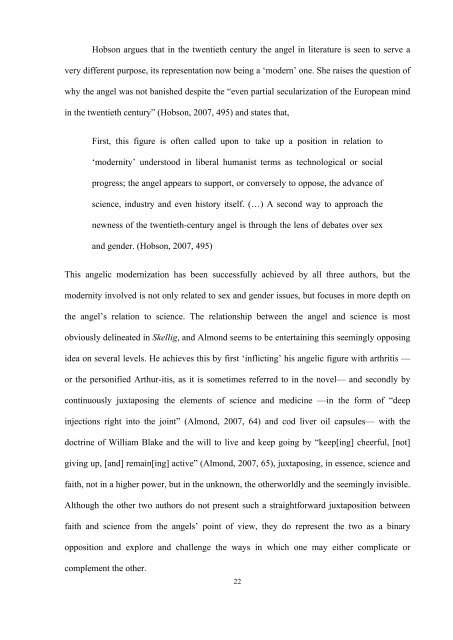The secular angel in contemporary children's literature: David ...
The secular angel in contemporary children's literature: David ...
The secular angel in contemporary children's literature: David ...
Create successful ePaper yourself
Turn your PDF publications into a flip-book with our unique Google optimized e-Paper software.
Hobson argues that <strong>in</strong> the twentieth century the <strong>angel</strong> <strong>in</strong> <strong>literature</strong> is seen to serve a<br />
very different purpose, its representation now be<strong>in</strong>g a ‘modern’ one. She raises the question of<br />
why the <strong>angel</strong> was not banished despite the “even partial <strong>secular</strong>ization of the European m<strong>in</strong>d<br />
<strong>in</strong> the twentieth century” (Hobson, 2007, 495) and states that,<br />
First, this figure is often called upon to take up a position <strong>in</strong> relation to<br />
‘modernity’ understood <strong>in</strong> liberal humanist terms as technological or social<br />
progress; the <strong>angel</strong> appears to support, or conversely to oppose, the advance of<br />
science, <strong>in</strong>dustry and even history itself. (…) A second way to approach the<br />
newness of the twentieth-century <strong>angel</strong> is through the lens of debates over sex<br />
and gender. (Hobson, 2007, 495)<br />
This <strong>angel</strong>ic modernization has been successfully achieved by all three authors, but the<br />
modernity <strong>in</strong>volved is not only related to sex and gender issues, but focuses <strong>in</strong> more depth on<br />
the <strong>angel</strong>’s relation to science. <strong>The</strong> relationship between the <strong>angel</strong> and science is most<br />
obviously del<strong>in</strong>eated <strong>in</strong> Skellig, and Almond seems to be enterta<strong>in</strong><strong>in</strong>g this seem<strong>in</strong>gly oppos<strong>in</strong>g<br />
idea on several levels. He achieves this by first ‘<strong>in</strong>flict<strong>in</strong>g’ his <strong>angel</strong>ic figure with arthritis —<br />
or the personified Arthur-itis, as it is sometimes referred to <strong>in</strong> the novel— and secondly by<br />
cont<strong>in</strong>uously juxtapos<strong>in</strong>g the elements of science and medic<strong>in</strong>e —<strong>in</strong> the form of “deep<br />
<strong>in</strong>jections right <strong>in</strong>to the jo<strong>in</strong>t” (Almond, 2007, 64) and cod liver oil capsules— with the<br />
doctr<strong>in</strong>e of William Blake and the will to live and keep go<strong>in</strong>g by “keep[<strong>in</strong>g] cheerful, [not]<br />
giv<strong>in</strong>g up, [and] rema<strong>in</strong>[<strong>in</strong>g] active” (Almond, 2007, 65), juxtapos<strong>in</strong>g, <strong>in</strong> essence, science and<br />
faith, not <strong>in</strong> a higher power, but <strong>in</strong> the unknown, the otherworldly and the seem<strong>in</strong>gly <strong>in</strong>visible.<br />
Although the other two authors do not present such a straightforward juxtaposition between<br />
faith and science from the <strong>angel</strong>s’ po<strong>in</strong>t of view, they do represent the two as a b<strong>in</strong>ary<br />
opposition and explore and challenge the ways <strong>in</strong> which one may either complicate or<br />
complement the other.<br />
22
















